Key Takeaways:
- Northern Gaza Strip: The IDF Nahal Brigade (162nd Division) conducted clearing operations in the northern and central Gaza Strip.
- Southern Gaza Strip: Israeli Prime Minister Benjamin Netanyahu approved plans for a military operation into Rafah.
- Lebanon: Lebanese Hezbollah has conducted at least six attacks from southern Lebanon into northern Israel.
- West Bank: Israeli forces clashed with Palestinian fighters in at least six locations in the West Bank.
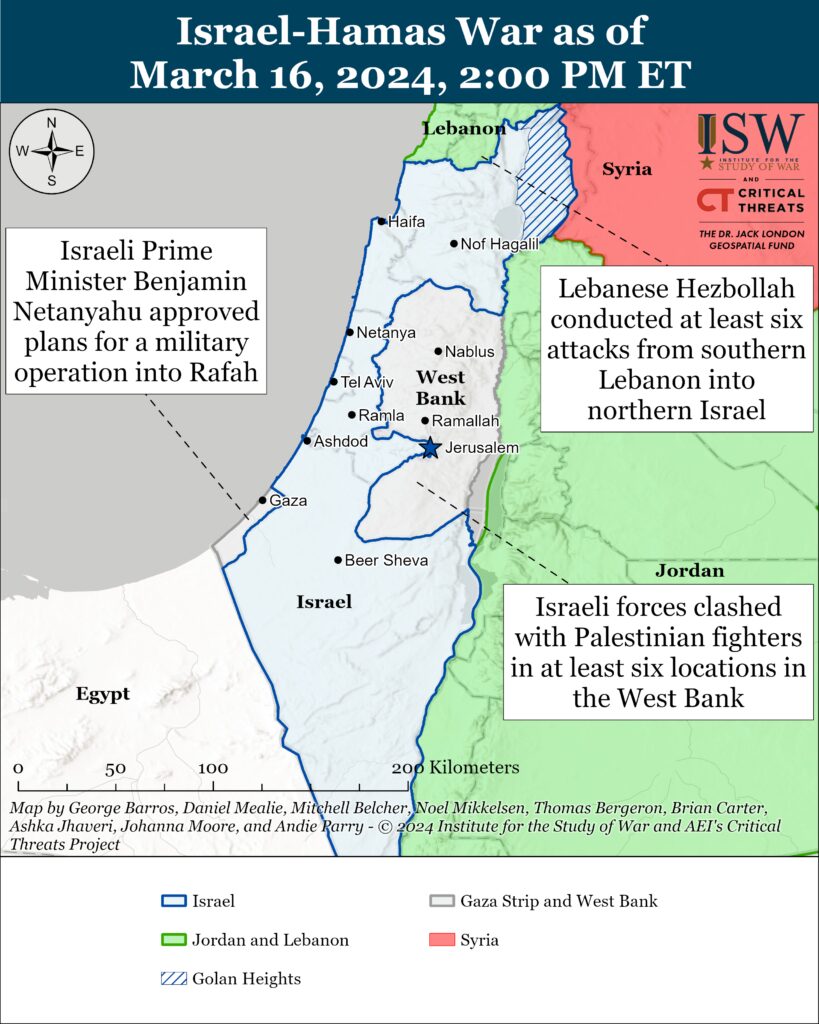
Gaza Strip
Axis of Resistance campaign objectives:
Erode the will of the Israeli political establishment and public to launch and sustain a major ground operation into the Gaza Strip
Degrade IDF material and morale around the Gaza Strip.The Israel Defense Forces (IDF) Nahal Brigade (162nd Division) conducted clearing operations in the northern and central Gaza Strip on March 16.[i] The IDF Nahal Brigade has been operating at the intersection of the northern and central Gaza Strip for two weeks.[ii] Israeli forces are launching raids from the ”Netzarim corridor” targeting Palestinian fighters. The “Netzarim corridor“ is where the IDF has been constructing a highway to support operations in the Gaza Strip.[iii] Israeli forces have destroyed Hamas military infrastructure in the area including weapons depots and rocket launchers.
The IDF 215th Artillery Brigade (162nd Division) received intelligence about Palestinian fighters hiding inside a Hamas-affiliated building and directed an airstrike that targeted the fighters.[iv] The IDF also killed a Hamas commander of a sniper unit.[v]
Israeli forces continued to conduct clearing operations in Khan Younis on March 16. Israeli infantrymen coordinated with the IDF Air Force to destroy a Hamas weapons depot.[vi] Commercially available satellite imagery captured on March 15 shows flattened terrain north of Hamad in northern Khan Younis, indicating that Israeli tanks or bulldozers operated in the area. The al Aqsa Martyrs’ Brigades, which is the self-proclaimed military wing of Fatah and aligned with Hamas in the war, detonated an unspecified explosive device targeting Israeli forces in Hamad.[vii]
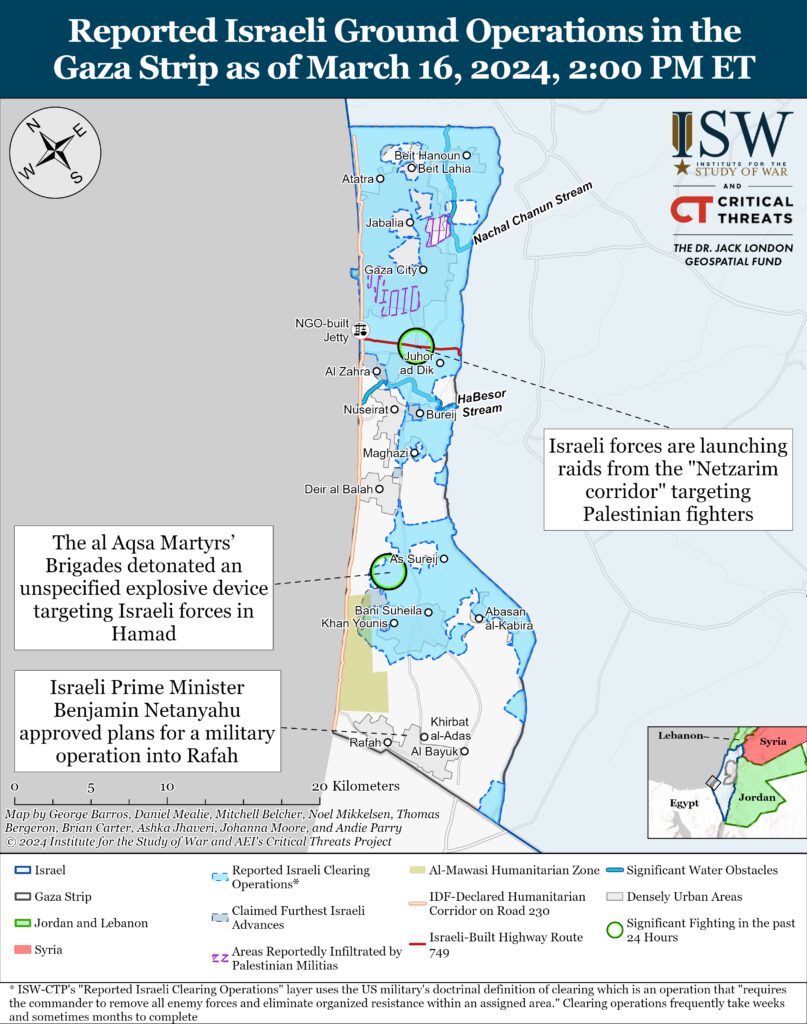
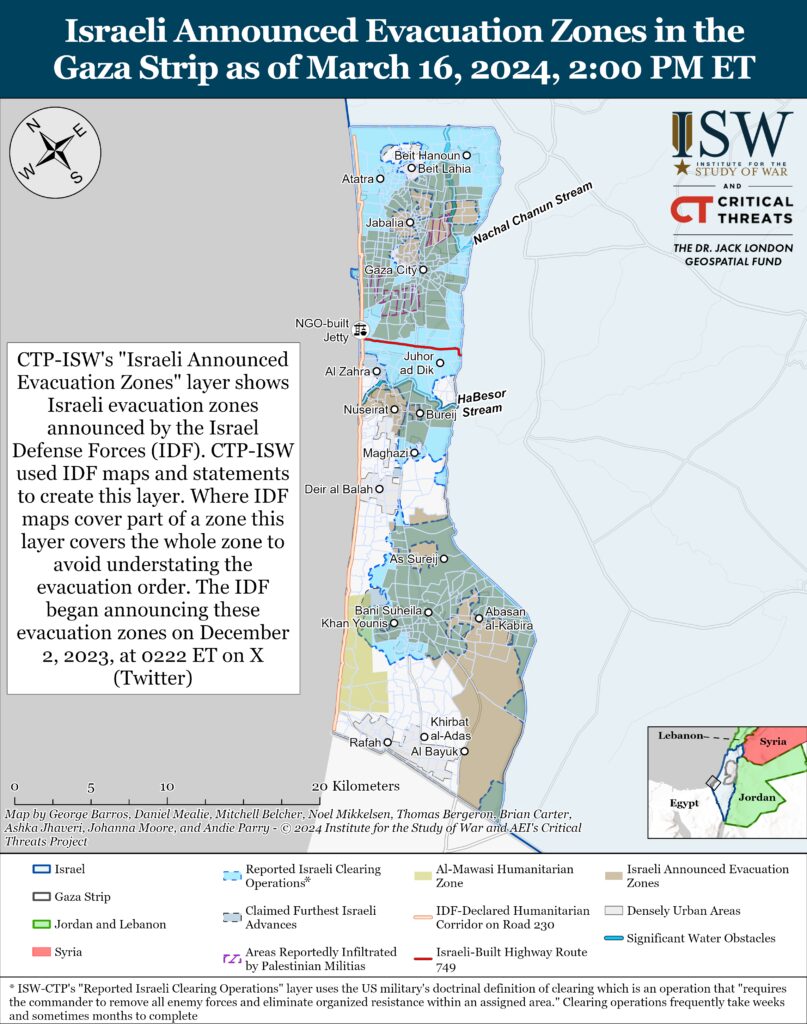
Fatah criticized Hamas for opposing PA President Mahmoud Abbas’ appointment of a new prime minister.[viii] Hamas stated on March 15 that Abbas’ decision is an “individual decision” that is “devoid of substance,” noting that Palestinians have lost confidence in the PA’s policies.[ix] Fatah officials argued that Hamas is responsible for the war in the Gaza Strip and unilaterally conducted the October 7 attack.[x]
Israeli Prime Minister Benjamin Netanyahu approved plans on March 15 for a military operation into Rafah.[xi] The Prime Minister’s Office did not provide additional details. US Secretary of State Antony Blinken told reporters that the Biden administration has not seen the plan and the Biden administration does not know how Israel plans to protect civilians in Rafah.[xii] The IDF said on March 13 that it plans to move civilians from Rafah to “humanitarian enclaves” in the central Gaza Strip before any Israeli offensive into Rafah.[xiii] There are approximately 1.4 million displaced Palestinian civilians currently in Rafah.
Israeli security officials told the Israeli security cabinet that the Israeli airstrike in the central Gaza Strip on March 11 likely killed Hamas military wing deputy commander Marwan Issa.[xiv] Israeli media reported that Israeli Prime Minister Benjamin Netanyahu said that Issa’s death is an “is an important and significant achievement for Israel.”[xv] Israeli journalists described Issa as the third most senior official in Hamas in the Gaza Strip.[xvi] Issa worked closely with Hamas leader in the Gaza Strip Yahya Sinwar and Hamas military wing commander Mohammad Deif to plan the October 7 attack.[xvii]
Palestinian fighters have conducted at least two indirect fire attacks from the Gaza Strip into Israel since CTP-ISW’s last data cutoff on March 15. PIJ fired rockets targeting Sderot in southern Israel on March 15.[xviii] Israeli air defenses intercepted one of the rockets and a second rocket landed outside the city.[xix] The Palestinian Mujahideen Movement fired rockets into southern Israel on March 16.[xx] Israeli Army Radio reported red alerts in Nahal Oz on March 16.[xxi]
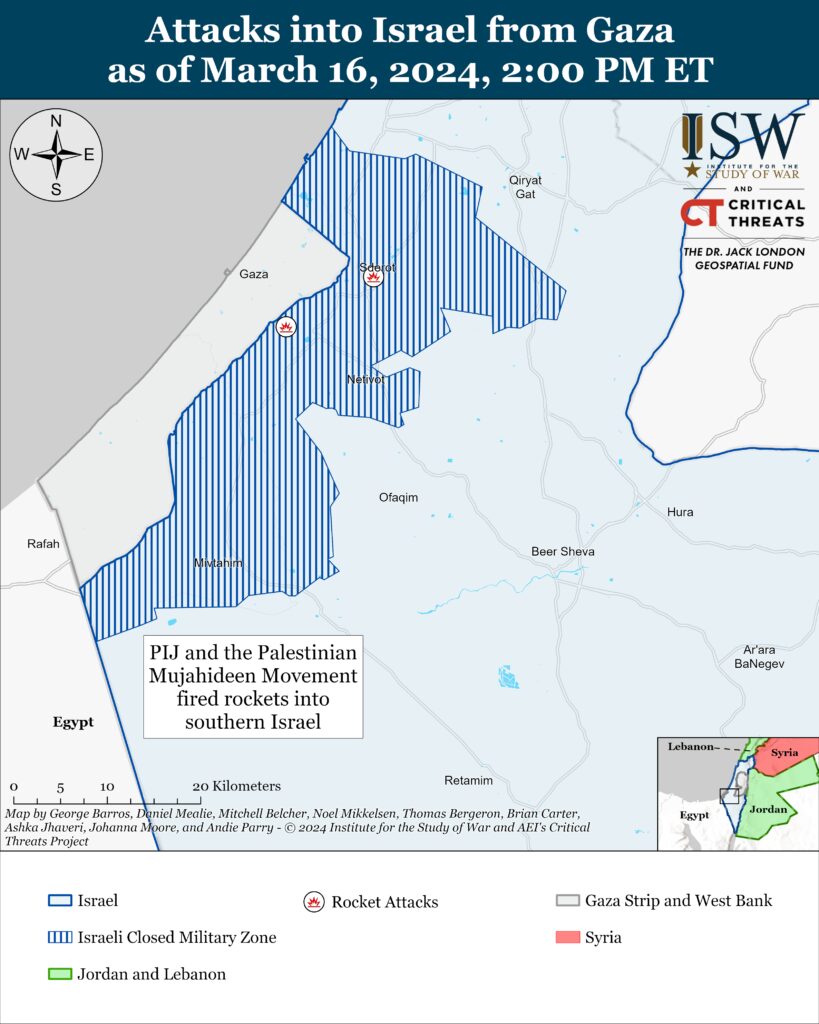
Fatah criticized Hamas for opposing PA President Mahmoud Abbas’ appointment of a new prime minister.[viii] Hamas stated on March 15 that Abbas’ decision is an “individual decision” that is “devoid of substance,” noting that Palestinians have lost confidence in the PA’s policies.[ix] Fatah officials argued that Hamas is responsible for the war in the Gaza Strip and unilaterally conducted the October 7 attack.[x]
Israeli Prime Minister Benjamin Netanyahu approved plans on March 15 for a military operation into Rafah.[xi] The Prime Minister’s Office did not provide additional details. US Secretary of State Antony Blinken told reporters that the Biden administration has not seen the plan and the Biden administration does not know how Israel plans to protect civilians in Rafah.[xii] The IDF said on March 13 that it plans to move civilians from Rafah to “humanitarian enclaves” in the central Gaza Strip before any Israeli offensive into Rafah.[xiii] There are approximately 1.4 million displaced Palestinian civilians currently in Rafah.
Israeli security officials told the Israeli security cabinet that the Israeli airstrike in the central Gaza Strip on March 11 likely killed Hamas military wing deputy commander Marwan Issa.[xiv] Israeli media reported that Israeli Prime Minister Benjamin Netanyahu said that Issa’s death is an “is an important and significant achievement for Israel.”[xv] Israeli journalists described Issa as the third most senior official in Hamas in the Gaza Strip.[xvi] Issa worked closely with Hamas leader in the Gaza Strip Yahya Sinwar and Hamas military wing commander Mohammad Deif to plan the October 7 attack.[xvii]
Palestinian fighters have conducted at least two indirect fire attacks from the Gaza Strip into Israel since CTP-ISW’s last data cutoff on March 15. PIJ fired rockets targeting Sderot in southern Israel on March 15.[xviii] Israeli air defenses intercepted one of the rockets and a second rocket landed outside the city.[xix] The Palestinian Mujahideen Movement fired rockets into southern Israel on March 16.[xx] Israeli Army Radio reported red alerts in Nahal Oz on March 16.[xxi]
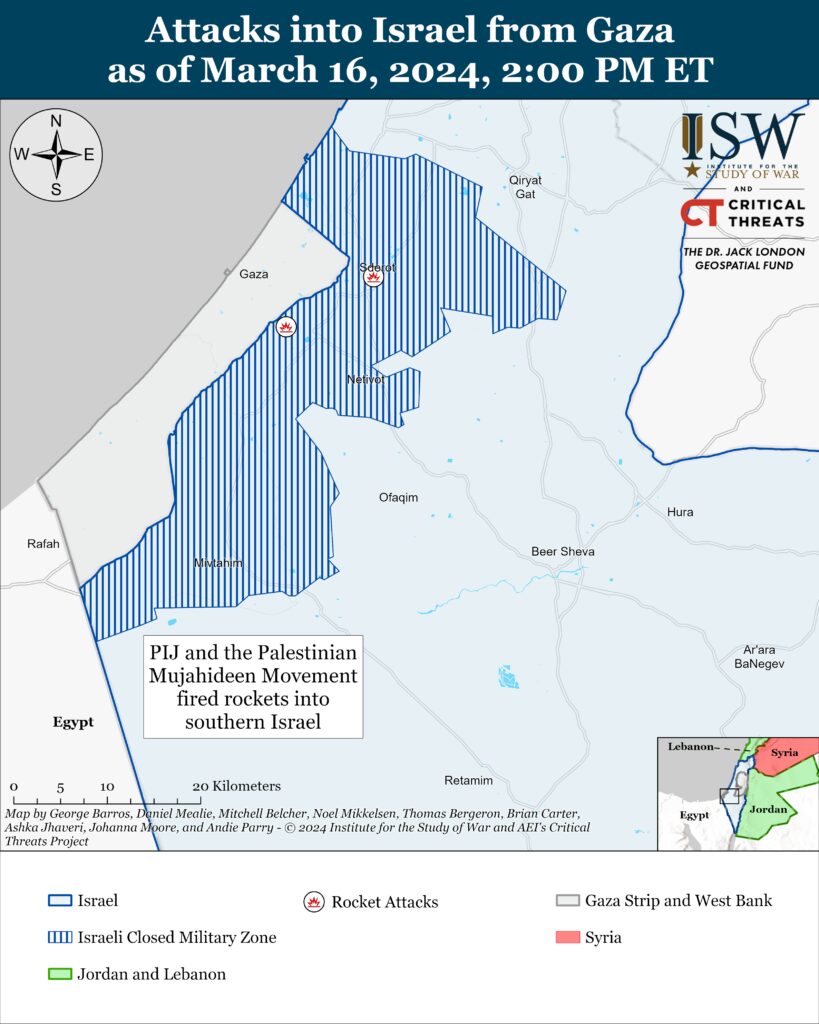
Recorded reports of attacks; CTP-ISW cannot independently verify impact.
West Bank
Axis of Resistance campaign objectives:
Draw IDF assets and resources toward the West Bank and fix them thereIsraeli forces have clashed with Palestinian fighters in at least six locations in the West Bank since CTP-ISW’s last data cutoff on March 15.[xxii] An imam from a local mosque fired small arms at an Israeli settlement in Hebron on March 16.[xxiii] Israeli forces later engaged and killed him.[xxiv]
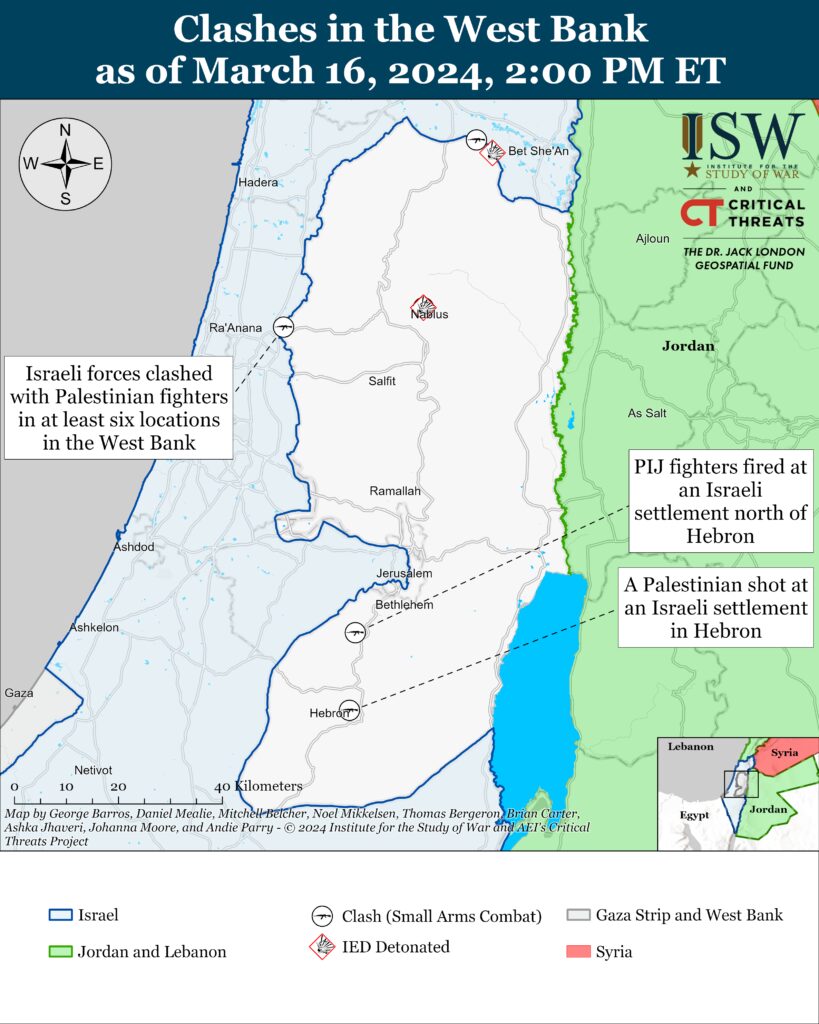
This map is not an exhaustive depiction of clashes and demonstrations in the West Bank.
Southern Lebanon and Golan Heights
Axis of Resistance campaign objectives:
Draw IDF assets and resources toward northern Israel and fix them there
Set conditions for successive campaigns into northern IsraelLebanese Hezbollah has conducted at least six attacks from southern Lebanon into northern Israel since CTP-ISW’s last data cutoff on March 15.[xxv]
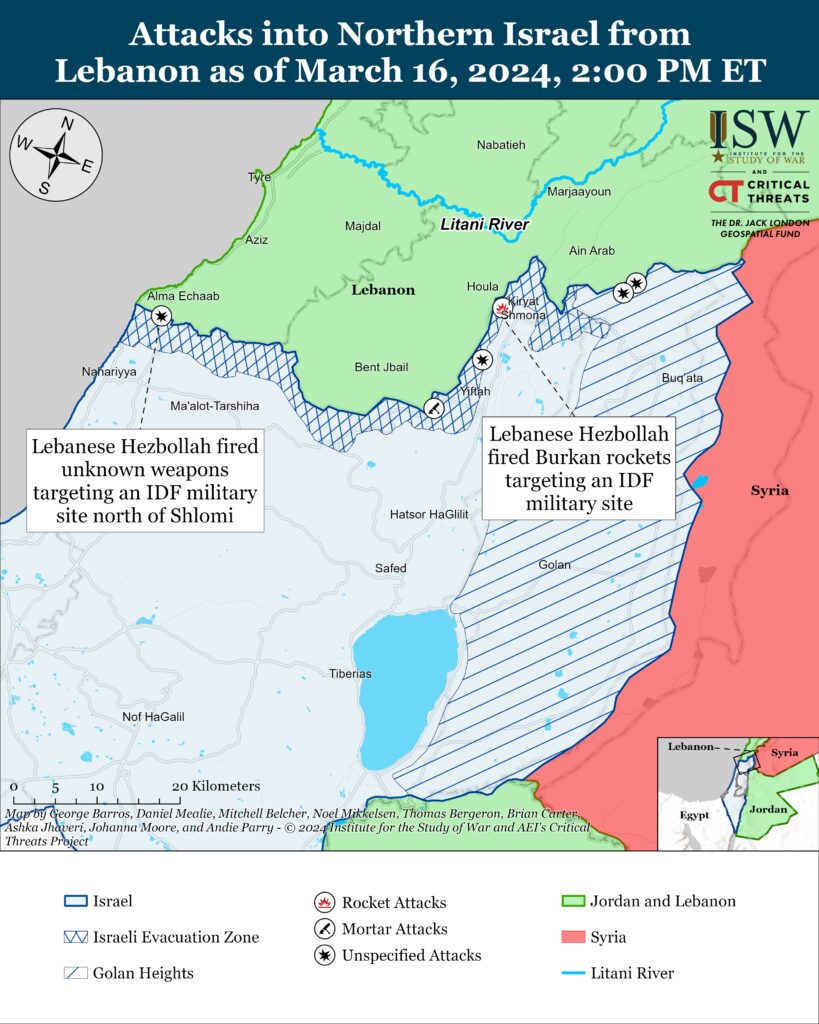
Recorded reports of attacks; CTP-ISW cannot independently verify impact.
 Eurasia Press & News
Eurasia Press & News



